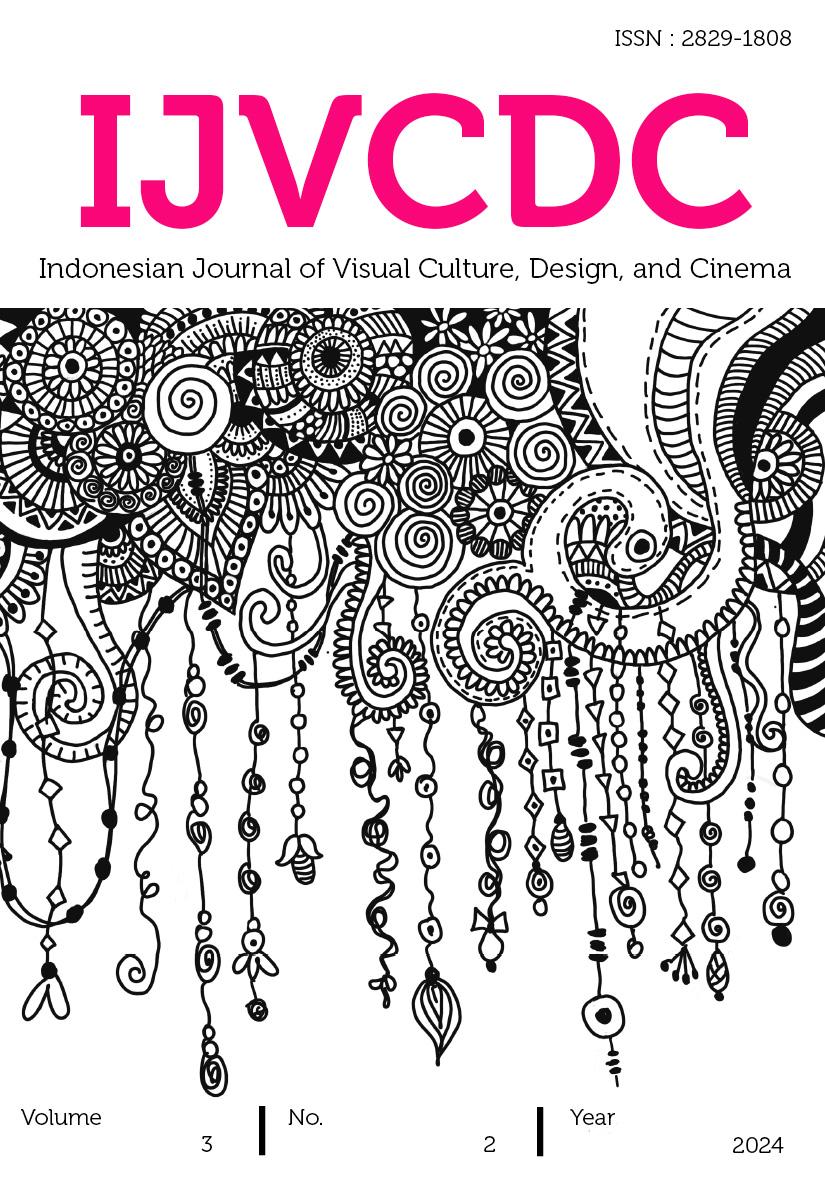Rebranding Destination Branding of Pontianak
DOI:
https://doi.org/10.21512/ijvcdc.v3i2.12416Keywords:
destination branding, cultural identity design, creative promotionAbstract
Pontianak is known as a city where equator line crosses, this has been the identity of Pontianak over the past decades. Pontianak needs a branding rejuvenations as it has a lot to offer from culinary to its cultural events. This project discuss about the new brand identity made for Pontianak: Beyond Equator. The objectives is to help Pontianak in rejuvenate and rebrand their identity which in hope could gain exposure and attract more tourist. The method used in this project is qualitative method with Literature review, interviews with head of tourism department of Pontianak and a branding expert, and observational analysis on the city current conditions. The results is Pontianak has a lot to offer which does not translate in the current branding. Create a new brand identity that is contemporary but still hold the cultural root along the branding. The brand identity should be beneficial to the city alongside with an effective and strong promotional online and on-site.
References
Adams, S. (2017). The designer's dictionary of color. New York: Quid Publishing
Adîr, V., Adîr, G., Pascu, N., E.(2009). Logo, as identity graphic vector. Acta Technica Napocensis,52, vol.Ia, 121-124 Retrieved from https://core.ac.uk/download/pdf/81973191.pdf
Anholt, S. (2006). Competitive identity : The new brand management for nations,
cities and regions. ProQuest Ebook Central. Retrieved from https://ebookcen- tral.proquest.com
Anholt, S. (2010). Places: Identity, image and reputation. Houndsmills, United Kingdom: Palgrave Macmillan.
Awtayuda, A. (2016). Pengaruh Kualitas Ruang Terbuka Publik Terhadap Ekspektasi Pengguna di Taman Alun-alun Kapuas, Kota Pontianak. JURNAL PEMBANGUNAN WILAYAH & KOTA, 12(1), 13. https://doi.org/10.14710/pwk.v12i1.11453
Badan Pusat Statistik (2019). Retrieved from https://kalbar.bps.go.id/publica- tion/2020/03/23/082d9358f116a111f92cb23a/statistik-angkutan-udara-provinsi-kali- mantan-barat-2019.html.
Blain, C., Levy, S., & Ritchie, J. (2005). Destination Branding: Insights and Practices from Destination Management Organizations. Journal Of Travel Research, 43(4), 328-338. Re- trieved from https://doi.org/10.1177/0047287505274646
Bennett, R., & Savani, S. (2003). THE REBRANDING OF CITY PLACES: AN INTER-
NATIONAL COMPARATIVE INVESTIGATION. International Public Manage- ment Review, 4(2), 70-88. Retrieved 3 April 2021, from https://www.re- searchgate.net/publication/228470205_The_Rebranding_of_City_Places_An_Inter- national_Comparative_Investigation.
Campelo, A., Aitken, R., Thyne, M., & Gnoth, J. (2013). Sense of Place. Journal Of Travel Research, 53(2), 154-166. Retrieved from https://doi.org/10.1177/0047287513496474
Canon, C. (2018). Cultural investigation on typography in branding in the United States and in Brazil. College Of Arts & Sciences Senior Honors Theses.
Retrieved from https://ir.library.louisville.edu/honors/155/
Chang, W., & Lin, H. (2010). The impact of color traits on corporate branding. African Journal Of Business Management, 4(15), 3345-3355. Retrieved 3 April 2021, from https://academicjournals.org/journal/AJBM/article-full-text-pdf/CF287D320855.pdf.
Clair, K., & Busic-Snyder, C. (2005). A Typographic Workbook: A Primer to History, Techniques, and Artistry, 2nd. John Wiley & Sons.
Clarke, J. (2003). Brand new justice: the upside of global branding by Simon Anholt. Butter- worth-Heinemann, Oxford. 2003. No. of pages: 180. ISBN 0-7506-56999.
International Journal Of Tourism Research, 5(6), 466-466. Retrieved from https://doi.org/10.1002/jtr.456
Dempsey, N., Brown, C., Raman, S., Porta, S., Jenks, M., Jones, C., & Bramley, G. (2008). Elements of Urban Form. Future City, 21-51. Retrieved from https://doi.org/10.1007/978- 1-4020-8647-2_2
Dinnie, K. (2010). City branding : Theory and cases. ProQuest Ebook Central.
Retrieved from https://ebookcentral.proquest.com
Esa. (2015). Ini Makna dan Filosofi di Balik Logo Baru 'Jogja Istimewa’. Jogja Tribun News. Retrieved from https://jogja.tribunnews.com/2015/02/06/ini-makna-dan- filosofi-di-balik-logo-baru-jogja-istimewa.
Filkovskaia, J. (2017). Influence of Visuals in Digital Brand Identity. Bachelor’S Thesis. Re- trieved 3 April 2021, from https://core.ac.uk/download/pdf/84793567.pdf.
Ganon, C.C. (2018). Cultural investigation on typography in branding in the United States and in Brazil.
Gilmore, F. (2002). “A Country—Can It Be Repositioned? Spain—The Success Story of Coun- try Branding.†Journal of Brand Management, 9 (4/5): 281-94. Retrieved from https://link.springer.com/article/10.1057/palgrave.bm.2540078
Hall, D. (1999). “Destination Branding, Niche Marketing and National Image Projection in Central and Eastern Europe.†Journal of Vacation Marketing, 5 (3): 227-37. Retrieved from https://journals.sagepub.com/doi/pdf/10.1177/135676679900500303
Haigh, D. (2000). Walking Away from a $3 Billion Brand. Accountancy Age, 14, 24
Hankinson, G. (2007). “The Management of Destination Brands: Five Guiding Principles Based on Recent Developments in Corporate Branding Theory.†Journal of Brand Management, 14 (3): 240-54.
Henderson, P., Cote, J., Leong, S., & Schmitt, B. (2003). Building strong brands in Asia: selecting the visual components of image to maximize brand strength. International Journal Of Research In Marketing, 20(4), 297-313. Retrieved from https://doi.org/10.1016/j.ijresmar.2003.03.001
Hospers, G.J. (2009), Citymarketing in Perspectief (in Dutch), IVIO, Lelystad,The Neth- erlands.
Jacobsen, B.P. (2012), "Place brand equity: a model for establishing the effectiveness of place brands", Journal of Place Management and Development, Vol. 5 No. 3, pp. 253-271. https://doi.org/10.1108/17538331211269657
Kotler, P., & Gertner, D. (2002). Country as brand, product, and beyond: A place marketing and brand management perspective. Journal Of Brand Management, 9(4), 249-261. Retrieved from https://doi.org/10.1057/palgrave.bm.2540076
Lee, S., & Bencekri, M. (2021). Urban form and public transport design. Urban Form And Accessibility, 289-306. https://doi.org/10.1016/b978-0-12-819822-3.00018-3
Lee, S., Rodriguez, L., & Sar, S. (2012). The influence of logo design on country image and willingness to visit: A study of country logos for tourism. Public Relations Re- view, 38(4), 584-591. Retrieved from https://doi.org/10.1016/j.pubrev.2012.06.006
Lefebvre, H. (2003). The urban Revolution (pp. 15-22). University of Minesotta Press. Re- trieved from http://www.oikodomos.org/workspaces/app/webroot/files/refer- ences/text/adiaconu_27_Section_1_Lefebvre.pdf
Lupton, Ellen. Thinking with Type: A Critical Guide for Designers, Writers, Editors, & Students. Princeton Architectural Press. 2010.
MacCannell, D. (1999), The Tourist: A New Theory of the Leisure Class , University of California Press, Berkeley, United States.
Mackenzie, D. (2006), "Encyclopedia of the City", Reference Reviews, Vol. 20 No. 6,
pp. 21-21. Retrieved from https://doi.org/10.1108/09504120610687137
Macomber, J. (2016). The 4 Types of Cities and How to Prepare Them for the Future. Harvard Business Review. Retrieved 3 April 2021, from https://hbr.org/2016/01/the-4-types-of- cities-and-how-to-prepare-them-for-the-future.
Mattern, S. (2008). Font of a Nation: Creating a National Graphic Identity for Qatar. Public Culture, 20(3), 479-496. https://doi.org/10.1215/08992363-2008-008
Marks, T. (2011). Color harmony compendium. Beverly, MA: Rockport Pub.
Marzano, G., Scott, N. (2009). “Power in Destination Branding.†Annals of Tourism Re- search, 36 (2): 247-67. Retrieved from https://www.sciencedirect.com/science/arti- cle/abs/pii/S0160738309000188
Mumford, L. (1990). What is a City?. Architectural Record. Retrieved 3 April 2021, from https://kisi.deu.edu.tr/mert.cubukcu/pdf/Mumford_1937.pdf.
Hubbard, P., & Hubbard, P. (2006). City. ProQuest Ebook Central. Retrieved from https://ebookcentral.proquest.com
Nugraha, D. (2012). Jogja Never Ending Asia. [Online] Repository. Retrieved from http://repository.upnyk.ac.id/4197/1/ABSTRAK.pdf
Ooi, C. (2002). Contrasting strategies: Tourism in Denmark and Singapore. Annals of Tourism Research. Volume 29, Issue 3, Pages 689-706. Retrieved from https://doi.org/10.1016/S0160-7383(01)00086-X
Paddison, R. (1993), “City marketing, image reconstruction and urban regenerationâ€, Urban Studies ,Vol. 30, No. 2, pp. 339– 350. Retrieved from https://jour- nals.sagepub.com/doi/abs/10.1080/00420989320080331
Parr, J. (2007). Spatial Definitions of the City: Four Perspectives. Urban Studies, 44(2), 381-
Retrieved from https://doi.org/10.1080/00420980601075059
Putri, A. (2020). Pengembangan Pariwisata Kalbar Butuh Inovasi, 300 Destinasi Belum Ter- garap Maksimal - Tribun Pontianak. Tribun Pontianak. Retrieved 3 April 2021, from https://pontianak.tribunnews.com/2020/02/02/pengembangan-pariwisata-kalbar-butuh- inovasi-300-destinasi-belum-tergarap-maksimal.
Rahman, M.N., Mehta, V., (2020) Interdisciplinary Journal of Signage and Wayfinding; Vol. 4, No. 1. Retrieved from https://journals.shareok.org/ijsw/article/view/59/46
Ritchie, J., & Ritchie, R. (1998). THE BRANDING OF TOURISM DESTINATIONS ~
PAST ACHIEVEMENTS & FUTURE CHALLENGES ~. Annual Congress Of The International Association Of Scientific Experts In Tourism. Retrieved from http://citeseerx.ist.psu.edu/viewdoc/down- load?doi=10.1.1.201.9520&rep=rep1&type=pdf
Sammut-Bonnici, T. (2015). Brand and Branding. Wiley Encyclopedia Of Management, 1-3.
Retrieved from https://doi.org/10.1002/9781118785317.weom120161
Shamai, S. (1991). Sense of Place: An Empirical Measurement. Geoforum 22(3):347-358. Retrieved from https://www.researchgate.net/publica- tion/229382037_Sense_of_Place_An_Empirical_Measurement
Smithson, E. (2015). What Is Branding and Why Is It Important for Your Business?. Branding- mag. Retrieved from https://www.brandingmag.com/2015/10/14/what-is-branding-and- why-is-it-important-for-your-business/
Stuart, H., & Muzellec, L. (2004). Corporate makeovers: Can a hyena be rebranded?. Journal Of Brand Management, 11(6), 472-482. Retrieved from https://doi.org/10.1057/pal- grave.bm.2540193
Syahroni,. (2012). Pontianak Perkenalkan Logo City Branding Resmi. Tribun Pontinak. Retrieved from https://pontianak.tribunnews.com/2017/02/06/pontianak-perkenal- kan-logo-city-branding-resmi?page=allan
Todor, R. (2014). THE IMPORTANCE OF BRANDING AND REBRANDING FOR STRA-
TEGIC MARKETING. Bulletin Of The Transilvania University Of BraÅŸov, 7(56), 60-64. Retrieved 3 April 2021, from http://rs.unitbv.ro/BU2014/Se- ries%20V/BULETIN%20V/I-08_TODOR%20Raluca.pdf.
UNWTO (United Nation. World Tourism Organization). (2011). Policy and Practice for Global Tourism, Madrid: UNWTO. Retrieved from https://www.e-un- wto.org/doi/book/10.18111/9789284413799
Urry, J. (2002[1990]), The Tourist Gaze: Leisure and Travel in Contemporary Societies , Second edition, Sage Publications, London, United Kingdom.
Villagomez, Nikki. Culture Typography: How Culture Affects Typography. HOW Books.
Yadav, Preeti. (2014). Typography as a statement of Design. Retrieved from https://www.researchgate.net/publication/316683307_Typography_as_a_state- ment_of_Design
Yhea, Y. (2019). The Importance of Tourism on Economies and Businesses. Glob- aledge.msu.edu. Retrieved from https://globaledge.msu.edu/blog/post/55748/the-im- portance-of-tourism-on-economies-a.
Živković, J. (2018). Urban Form and Function. Encyclopedia Of The UN Sustainable De- velopment Goals, 1-10. Retrieved from https://doi.org/10.1007/978-3-319-71063- 1_78-1
Downloads
Published
How to Cite
Issue
Section
License
Copyright (c) 2024 Vania Tanjaya

This work is licensed under a Creative Commons Attribution-NonCommercial-ShareAlike 4.0 International License.







